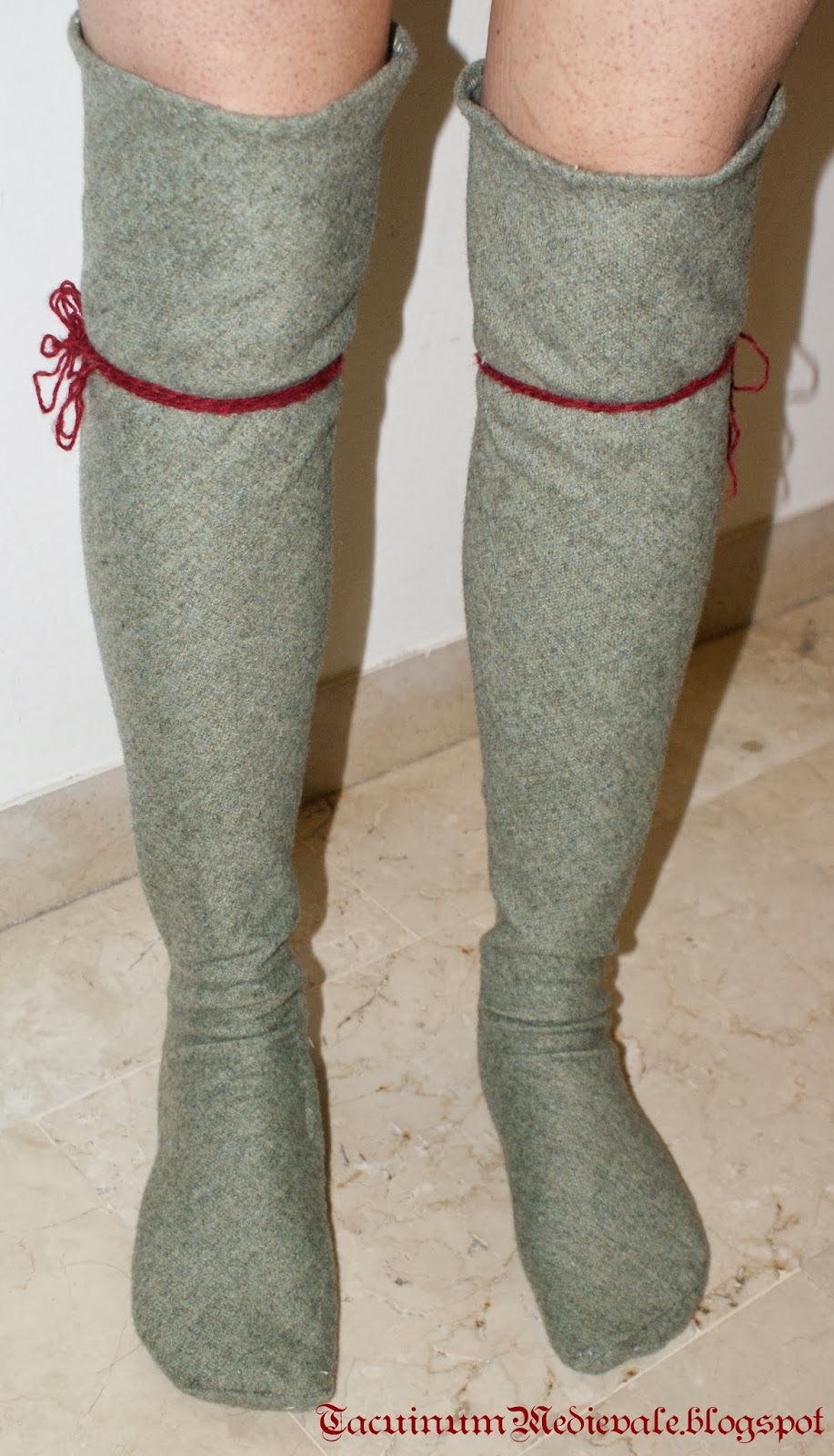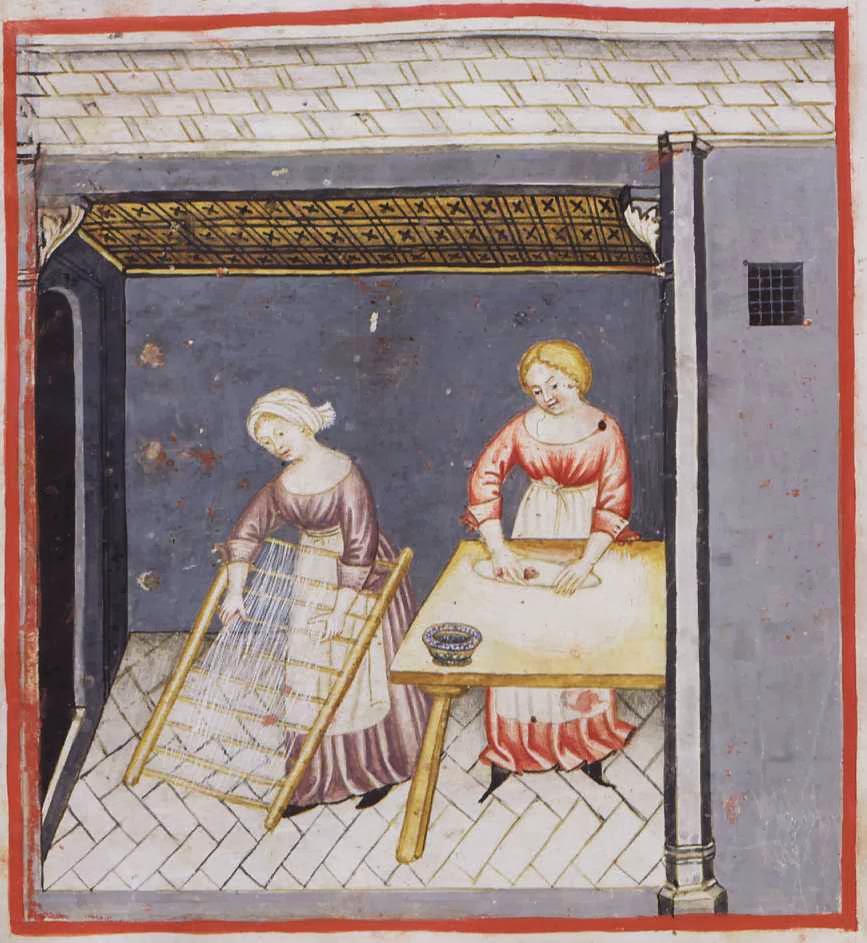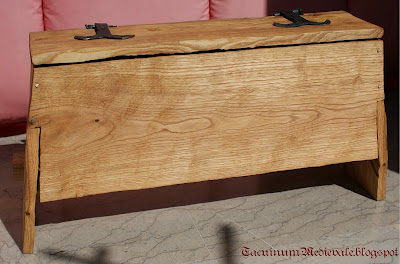| Les Très Riches Heures du duc de Berry, Febbraio |
Una nota interessante proviene da Rosalie's Medieval Woman
Hose, as well as socks, were worn by medieval women. Our model woman Margherita Datini's wardrobe account of 1339 lists both white linen undersocks and long hose of silk or wool. The wife of a wealthy Italian merchant, Margherita had access to commercially produced items in the town, and would have worn what regular women of her class wore.Ovviamente sarebbe interessante individuare il documento per un confronto (e verificare la data citata, dal momento che Margherita nasce nel 1360 e muore nel 1423...) e vedere anche quali sono i termini originari tradotti con "undersocks" e "hose".
Tanto per darvi un'idea del modello che avevo in mente cucendo le mie calze, ecco un'immagine dal celeberrimo Les Très Riches Heures du duc de Berry, Francia, 1412 circa: due donne e un uomo si stanno scaldando davanti al fuoco, quella verso il fondo mostra chiaramente delle calze che sembrano arrivare fino al ginocchio, tenute forse ferme da una striscia di tessuto dello stesso colore (mostra anche qualcos'altro, ma non facciamoci caso...!). Anche la donna in primo piano ha probabilmente delle calze marrone chiaro.
 |
| Calze terminate, mancano le giarrettiere! Finished hoses, garters yet to come! |
Il modello che ho utilizzato per le mie calze proviene dal Medieval Tailor's Assistant (pag. 104 sgg., fig. 7a): ho scelto il modello privo di cuciture sotto la pianta del piede, fidandomi, senza fare prima una ricerca, e, quando ormai le calze erano cucite, mi sono resa conto che non avevo ancora trovato un solo reperto della forma da me scelta. Per il momento mi assolvo dai miei peccati e tengo queste, quando farò le prossime sceglierò un modello documentato. L'aspetto che ritengo davvero fondamentale, tanto per le calze che per le calzabraghe da uomo, è l'aderenza, il fitting. Per ottenerlo, è importante partire da un modello personalizzato: io ho usato della stoffa di scarto e mi sono fatta aiutare a modellarla il più possibile. Riportando poi il modello sul tessuto finale,ho tagliato in diagonale il tessuto, per avere maggiore elasticità (dagli schemi del Medieval Tailor's Assistant dovrebbe risultare abbastanza chiaro il procedimento.)
Ho scelto della spessa lana grigia, per le mie calze, e ho cucito tutto a mano utilizzando del filo di lino bianco incerato. Ho usato il punto indietro per le cuciture principali, ho ribattuto tutte le cuciture usando il sottopunto (un lavoro lungo e noioso, ma utile per non avere la pressione della stoffa non ben distesa e anche per irrobustire le cuciture, evitando che la lana si sfilacci) e ho utilizzato, per i piccoli gheroni laterali, la tecnica testimoniata dai reperti della Groenlandia, cucendo cioè dal lato dritto del capo, non a rovescio. La tecnica, che a Battle of Visby abbiamo chiamato "The Perfect Gore", permette di centrare bene il gherone e di evitare i difetti che si possono verificare cucendo a rovescio. (Trovate su La Cotte Simple la spiegazione, utile per i gheroni di ogni capo d'abbigliamento) |
| Work in progress! |
***
I finished my hoses just in time for Christmas! I should hang them near the Christmas Tree and see if Santa will leave any present for me... Actually, I've bought myself enough presents, we'll open them together when my parcel arrives.
But let's go back to my hoses - or stockings. I don't have much to say about artistic sources, because I've never seen any depiction in italian art, also because of the lack of images of women showing their legs or even their feet. A weak clue is, here and there, something coloured which can be seen inside the shoes. An interesting note comes from Rosalie's Medieval Woman:
Hose, as well as socks, were worn by medieval women. Our model woman Margherita Datini's wardrobe account of 1339 lists both white linen undersocks and long hose of silk or wool. The wife of a wealthy Italian merchant, Margherita had access to commercially produced items in the town, and would have worn what regular women of her class wore.Obviously it would be interesting to find the document to ger more informations (ad verify the reported year, since Margherita was born in 1360 and dies in 1423...) and see also which are the original italian terms translated as "undersocks" and "hose".
Just to give you a clue of the model I had in mind while sewing my hoses, you can see a miniature from the famous Les Très Riches Heures du duc de Berry, France, about 1412: two women and a men are warming in front of the fireplace, the one at the bottom with the blue dress shows hoses reaching her knees, kept in place probably by a strap made of the same fabric (she is also showing something else, but let's not pay too much attention to it...!). The woman at the front may also be wearing light brown hoses.
 |
| L'interno del gherone. / The inside of the gore. |
I think the fitting is truly important both for women's or men's hoses: to gain it, it's important to start from a personal pattern. I used scrap fabric and asked for help to make it as tight as possible. Cutting the wool, I decided to make a diagonal cut to have more elasticity (from the Medieval Tailor's Assistant schemes the process results quite clear).
 |
| Il piede il gherone visto da fuori. / The foot and the gore. |
I chose thick grey wool for the stockings and I hand-sew them using white waxed linen thread. I used backstitch for the main seams, I flattened all the seams using hem-stitch (a long and boring work, but useful to avoid messed fabric around the foot, to strenghten the garment and to prevent wool from raveling) and I used for the small "side-gores" a technique well documented by the Greenland clothes, i.e. I sew the gores from the right side, not from the wrong one. This technique, which we called "the Perfect Gore" at Battle of Visby, allows to place easily the gore in place and helps to avoid the flaws due to the wrong-side seams. On La Cotte Simple you can find useful instructions for every kind of garment.





,+San+Nicola+di+Bari+con+le+3+fanciulle,+part..jpg)

,+c.+1370-1400+(fol.+104v)+linen+clothing.jpg)
,+c.+1370-1400.jpg)


.jpg)























